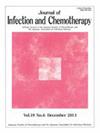The relationship between severe acute respiratory syndrome coronavirus 2 omicron variant epidemic and acute myocardial infarction: A self-controlled case series study
IF 1.9
4区 医学
Q3 INFECTIOUS DISEASES
引用次数: 0
Abstract
Background
The coronavirus disease 2019 (COVID-19) pandemic has led to various complications, including cardiovascular events. Despite the widespread impact of the severe acute respiratory syndrome coronavirus 2 (SARS-CoV-2) Omicron variant in 2022, no studies have evaluated the relationship between the Omicron variant epidemic and acute myocardial infarction (AMI).
Methods
We utilized a Japanese claims database to identify patients diagnosed with COVID-19 between January 1, 2022, and December 31, 2022. We also identified patients who developed AMI within 90 days before and after their COVID-19 diagnosis. A self-controlled case series (SCCS) analysis evaluated the incidence rate ratio (IRR) for AMI.
Results
Of the 360,589 patients with COVID-19, 759 were diagnosed with AMI. Excluding the day of exposure, the SCCS analysis showed an IRR for AMI of 6.65 (95 % confidence interval [CI]: 4.66–9.48, P < 0.001) for the 1st week, 1.90 (95 % CI: 1.05–3.50, P = 0.03) for the 2 nd week, and 0.95 (95 % CI: 0.52–1.72, P = 0.87) for the 3rd and 4th weeks following COVID-19. Including the day of exposure, the IRR was 77.4 (95 % CI: 63.2–94.9, P < 0.001) for the 1st week, 1.90 (95 % CI: 1.05–3.50, P = 0.03) for the 2 nd week, and 0.95 (95 % CI: 0.52–1.72, P = 0.87) for the 3rd and 4th weeks following COVID-19.
Conclusions
This study showed that the SARS-CoV-2 Omicron variant epidemic increased AMI incidence. These findings highlight AMI as a COVID-19 characteristic, emphasize the importance of SARS-CoV-2 vaccination, and underline the need for continued vigilance, even with variant changes.
严重急性呼吸系统综合征冠状病毒 2 Omicron 变异流行与急性心肌梗死之间的关系:自我控制病例系列研究》。
本文章由计算机程序翻译,如有差异,请以英文原文为准。
求助全文
约1分钟内获得全文
求助全文
来源期刊

Journal of Infection and Chemotherapy
INFECTIOUS DISEASES-PHARMACOLOGY & PHARMACY
CiteScore
4.10
自引率
4.50%
发文量
303
审稿时长
47 days
期刊介绍:
The Journal of Infection and Chemotherapy (JIC) — official journal of the Japanese Society of Chemotherapy and The Japanese Association for Infectious Diseases — welcomes original papers, laboratory or clinical, as well as case reports, notes, committee reports, surveillance and guidelines from all parts of the world on all aspects of chemotherapy, covering the pathogenesis, diagnosis, treatment, and control of infection, including treatment with anticancer drugs. Experimental studies on animal models and pharmacokinetics, and reports on epidemiology and clinical trials are particularly welcome.
 求助内容:
求助内容: 应助结果提醒方式:
应助结果提醒方式:


